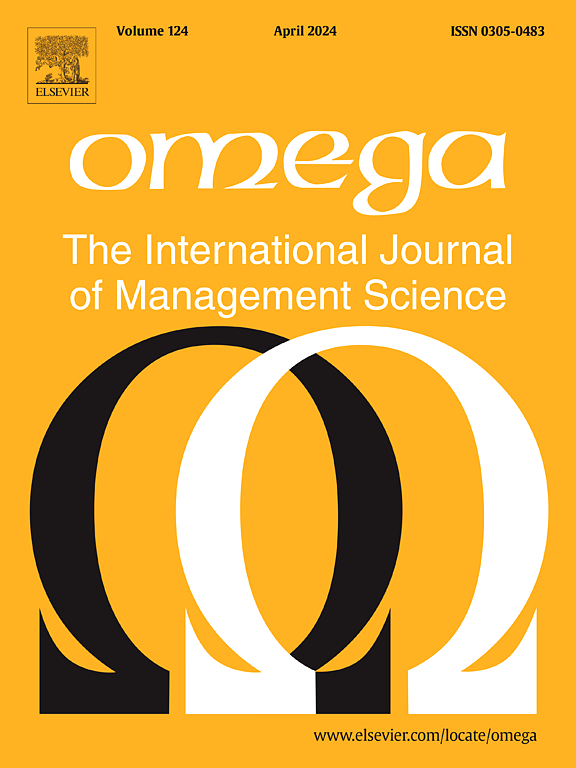论需求与回报自相关条件下混合制造与再制造系统的牛鞭行为
IF 6.7
2区 管理学
Q1 MANAGEMENT
Omega-international Journal of Management Science
Pub Date : 2024-10-05
DOI:10.1016/j.omega.2024.103209
引用次数: 0
摘要
本研究探讨了在自相关自回归综合移动平均(ARIMA)需求和校正收益的情况下,由订购到补货政策补充的混合制造-再制造系统的牛鞭行为。需求自相关现象在汽车、饮料、果蔬等多个行业中普遍存在。然而,在闭环供应链(CLSCs)系统动力学背景下,只有一阶向量自回归(VAR(1))和独立同分布(i.i.d.)过程得到了研究。因此,通过使用 z 变换和离散时间模拟,我们探讨了 i.i.d、AR(1)、一阶移动平均(MA(1))和一阶自回归移动平均(ARMA(1,1))需求过程下的牛鞭效应和库存方差。研究发现,对于具有自回归需求特征的产品,牛鞭随自回归需求参数的增加而减少,而自回归收益参数对牛鞭的影响呈 U 型。对于具有移动平均需求模式的产品,牛鞭随移动平均需求参数的增加而增加,随移动平均回报参数的增加而减少。此外,包括退货率、库存比例控制器和预测平滑等系统参数不仅直接影响牛鞭和库存方差,而且在影响需求过程与牛鞭/库存方差之间的关系方面起着调节作用。这些发现对控制与自回归和移动平均需求过程相关的产品牛鞭成本具有重要的管理意义。本文章由计算机程序翻译,如有差异,请以英文原文为准。
On the bullwhip behaviour of a hybrid manufacturing and remanufacturing system under autocorrelated demand and returns
This study explores the bullwhip behaviour of a hybrid manufacturing-remanufacturing system, replenished by the order-up-to policy, under auto-correlated autoregressive and integrated moving average (ARIMA) demand and corrected returns. The phenomena of demand auto-correlation are common in various industries such as automobile, beverage, and fruit and vegetables industries. However, only first-order vector autoregressive (VAR(1)) and independent and identically distributed (i.i.d.) process have been studied in the context of closed loop supply chains (CLSCs) system dynamics. Therefore, by using -transform and discrete-time simulation, we explore bullwhip and inventory variance under i.i.d, AR (1), first-order moving average (MA(1)) and first-order autoregressive and moving average (ARMA(1,1)) demand processes. It is found that, for products that have autoregressive demand characteristics, bullwhip decreases with the autoregressive demand parameter, while autoregressive return parameter has a U-shaped impact on the bullwhip. For those with moving average demand patterns, bullwhip increases with the moving average demand parameter and decreases with the moving average return parameter. Also, system parameters including return rate, inventory proportional controller and forecasting smoothing not only directly impact on bullwhip and inventory variance, but also act as the moderator in influencing the relationship between demand processes and bullwhip/inventory variance. These findings imply important managerial implication to control the bullwhip costs associated with products characterised by both autoregressive and moving average demand processes.
求助全文
通过发布文献求助,成功后即可免费获取论文全文。
去求助
来源期刊

Omega-international Journal of Management Science
管理科学-运筹学与管理科学
CiteScore
13.80
自引率
11.60%
发文量
130
审稿时长
56 days
期刊介绍:
Omega reports on developments in management, including the latest research results and applications. Original contributions and review articles describe the state of the art in specific fields or functions of management, while there are shorter critical assessments of particular management techniques. Other features of the journal are the "Memoranda" section for short communications and "Feedback", a correspondence column. Omega is both stimulating reading and an important source for practising managers, specialists in management services, operational research workers and management scientists, management consultants, academics, students and research personnel throughout the world. The material published is of high quality and relevance, written in a manner which makes it accessible to all of this wide-ranging readership. Preference will be given to papers with implications to the practice of management. Submissions of purely theoretical papers are discouraged. The review of material for publication in the journal reflects this aim.
 求助内容:
求助内容: 应助结果提醒方式:
应助结果提醒方式:


